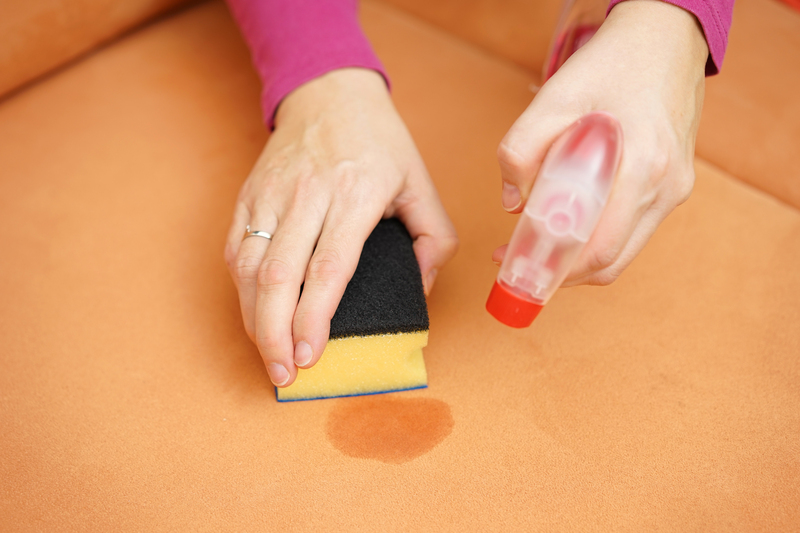Strategies for Better Air Quality at Home and Work
Posted on 28/09/2025
Strategies for Better Air Quality at Home and Work
Air quality is an essential factor for overall health and well-being, affecting everything from respiratory health to productivity and comfort. Poor indoor air quality at home or in the workplace can lead to allergies, headaches, fatigue, and even long-term health problems. With most people spending a significant part of their day indoors, understanding effective strategies for better air quality is crucial. This comprehensive guide explores practical tips and solutions to achieve cleaner, fresher air in your indoor spaces.

Why is Indoor Air Quality Important?
Many are surprised to learn that indoor air can be two to five times more polluted than outdoor air. Maintaining good air quality indoors is vital for both homes and workplaces due to the following reasons:
- Health Benefits: Clean air reduces the risk of respiratory illnesses, allergies, and asthma.
- Productivity: Improved air quality in workplaces leads to better concentration and fewer sick days.
- Comfort: Removing odors and irritants makes indoor environments more pleasant.
- Long-term Savings: Effective air quality management can lower healthcare and maintenance costs.
Major Indoor Air Pollutants: What Are You Breathing?
To develop strategies for air quality improvement, it's important to recognize the common pollutants that compromise your indoor environments:
- Particulate Matter (PM2.5, PM10): Small particles from dust, smoke, and combustion sources that can penetrate deep into the lungs.
- Volatile Organic Compounds (VOCs): Chemicals emitted from paints, cleaning products, furniture, and building materials.
- Mold and Mildew: Fungi that thrive in damp areas and release spores, causing allergies and respiratory issues.
- Pet Dander and Pollen: Allergens introduced by pets or from outdoor air.
- Carbon Monoxide (CO): A dangerous, odorless gas from fuel-burning appliances.
- Radon Gas: A radioactive gas that can seep into homes through the ground, linked to lung cancer.
Key Strategies for Better Air Quality at Home
1. Ensure Adequate Ventilation
Proper ventilation is the backbone of maintaining healthy air indoors. Here's how to enhance ventilation at home:
- Open Windows: Regularly open windows to allow fresh outdoor air to circulate indoors, especially when cooking or cleaning.
- Use Exhaust Fans: Install and use exhaust fans in the kitchen and bathroom to remove pollutants and moisture.
- Cross-Ventilation: Create airflow by opening windows on opposite sides of your home, allowing air to cross through rooms.
2. Control Humidity Levels
Humidity plays a big role in indoor air quality. High humidity encourages mold growth and dust mites, while low humidity causes dry skin and irritates respiratory tracts.
- Maintain Optimum Humidity: Keep indoor humidity between 30-50% using a dehumidifier or humidifier as needed.
- Fix Leaks Promptly: Address plumbing leaks and water damage quickly to prevent mold growth.
3. Regular Cleaning and Dust Control
Frequent cleaning can significantly reduce allergens and particles:
- Vacuum Regularly: Use a vacuum equipped with a HEPA filter on floors, rugs, and upholstery.
- Wet Dust Surfaces: Use damp cloths rather than dry dusting to prevent stirring up dust.
- Wash Linens Often: Clean sheets, pillowcases, and curtains in hot water to remove allergens.
4. Minimize Chemical Pollutants
Everyday products can emit harmful chemicals into the air. Here's how to reduce these contaminants:
- Choose Low-VOC Products: Select paints, finishes, and cleaning supplies labeled as low or zero VOC.
- Store Chemicals Safely: Keep household chemicals in sealed containers and out of living areas.
- Avoid Air Fresheners: Many contain VOCs; opt for natural alternatives like essential oils (used sparingly).
5. Use Air Purifiers
Air purifiers can be a game-changer, especially in rooms with high pollution sources or for sensitive individuals.
- HEPA Filters: True HEPA air purifiers can remove up to 99.97% of airborne particulates.
- Activated Carbon: Purifiers with carbon filters help absorb gases and odors.
- UV-C Sterilization: Some models offer ultraviolet light to kill airborne germs and mold spores.
6. Incorporate Houseplants
Certain houseplants have been shown to absorb toxins and increase humidity. Some popular air-cleaning plants include:
- Spider Plant (Chlorophytum comosum)
- Peace Lily (Spathiphyllum)
- Snake Plant (Sansevieria)
- Bamboo Palm (Chamaedorea seifrizii)
Note: Some plants may be toxic to pets. Choose carefully if you have animals at home.
Effective Air Quality Improvement at Work
1. Upgrade HVAC Systems
Modern workplaces often rely on central heating, ventilation, and air conditioning (HVAC) systems. To ensure better workplace air quality:
- Maintain HVAC Systems: Schedule regular maintenance and replace filters as recommended.
- Upgrade to High-Efficiency Filters: Use MERV-rated filters to capture fine particles.
- Balance Airflow: Ensure air ducts and vents are unobstructed for proper circulation.
2. Implement No-Smoking Policies
Tobacco smoke contains thousands of harmful chemicals. Implementing a strict no-smoking policy in and around workplaces is crucial for maintaining clean air.
3. Limit Use of Office Chemicals
Offices use various products that can degrade indoor air quality:
- Choose Eco-Friendly Products: Select non-toxic, fragrance-free cleaning chemicals.
- Reduce Printing: Printers and copiers emit ozone and VOCs; place them in well-ventilated areas.
- Encourage Digital Communication: Reducing paper use also limits excess printing and associated pollutants.
4. Optimize Office Layout and Workspace Design
Space planning impacts both airflow and pollutant exposure:
- Allow Adequate Space: Avoid overcrowding to minimize the spread of germs and improve air circulation.
- Integrate Green Spaces: Desk plants can help reduce pollutants and enhance air moisture.
5. Monitor Air Quality
Installing air quality monitors in offices can provide real-time data on pollutants, CO2, and humidity levels. Use this information to:
- Identify Trouble Spots: Address areas with recurring problems (e.g., poor ventilation).
- Respond Quickly: Take action if pollutant levels spike, such as increasing ventilation or removing contaminants.
Additional Tips for Keeping Indoor Air Clean
1. Ban Idling Vehicles Near Buildings
Encourage staff and visitors to avoid idling cars near air intakes or entrances, which can introduce vehicle exhaust indoors.
2. Maintain Building Materials and Furnishings
Older buildings may contribute to poor indoor air quality through off-gassing of formaldehyde or containing asbestos. Renovate responsibly by:
- Using Low-Emission Materials: Choose certified, environmentally friendly materials.
- Testing for Hazards: Conduct regular checks for radon, asbestos, or lead paint.
3. Promote Healthy Indoor Habits
- No Indoor Burning: Avoid burning candles, incense, or wood stoves indoors unless well-ventilated.
- Discourage Scented Products: Personal air fresheners and perfumes add unnecessary chemicals to shared air.
Special Considerations for Sensitive Individuals
For those with allergies, asthma, or compromised immune systems, strategies for better air quality become even more important:
- Allergen-Proof Your Home: Use allergy-proof pillow and mattress covers.
- Keep Pets Clean: Bathe and groom pets regularly; keep them out of bedrooms.
- Maintain HVAC Filters: Consider using medical-grade filters if recommended by a healthcare professional.

Frequently Asked Questions
How Often Should I Change My Air Filter?
Generally, change your HVAC air filter every 1-3 months, but replace more frequently if you have pets, allergies, or high dust levels.
Are Air Purifiers Worth the Investment?
For homes and offices in polluted areas or with allergen concerns, air purifiers can significantly reduce particulate matter and some chemical pollutants. Look for models that combine HEPA filtration with activated carbon for broad-spectrum coverage.
Do Houseplants Really Improve Air Quality?
While houseplants can boost indoor air quality by removing certain toxins, their effect is more modest than mechanical filtration systems. Nonetheless, they contribute additional benefits such as increased humidity and improved aesthetics.
Conclusion: Breathing Easier Indoors
Achieving better air quality at home and work requires a holistic approach: control sources of pollution, regularly clean, maintain proper ventilation, and use air cleaning devices as needed. By adopting these strategies for indoor air quality improvement, you'll create a healthier, more comfortable environment for you, your family, and your coworkers.
If you're ready to take your efforts to the next level, consider working with a certified indoor air quality professional who can assess your space and recommend personalized solutions. Remember, every little improvement counts toward a healthier lifestyle and increased productivity. Breathe easy--you've got this!



